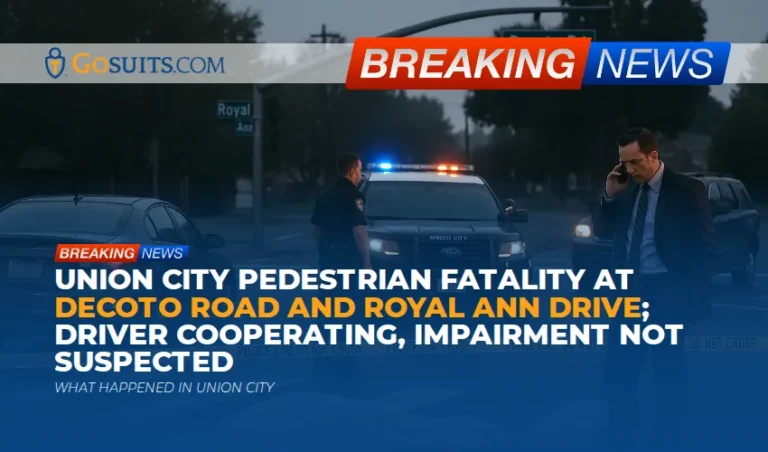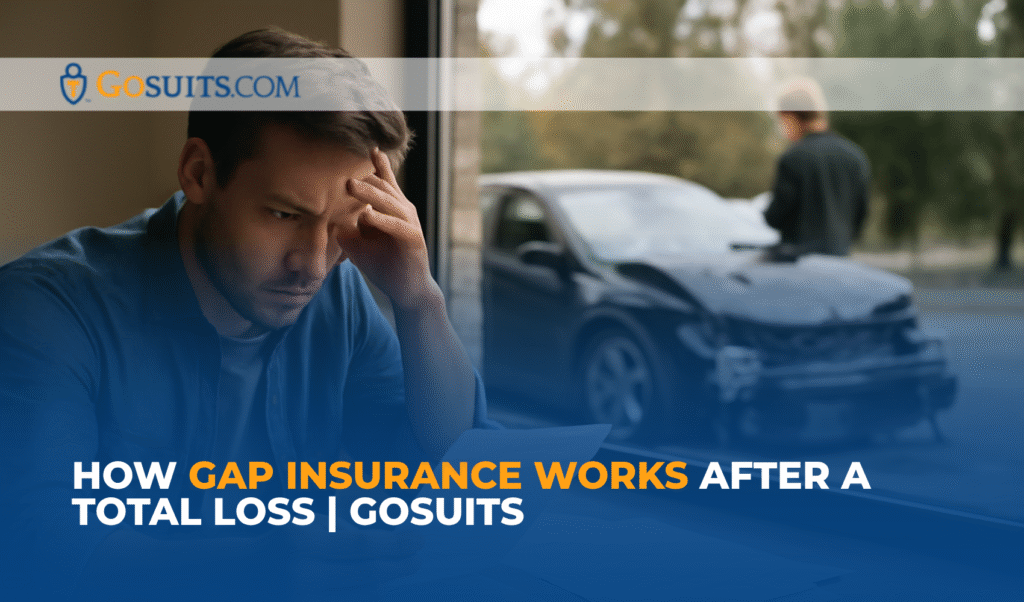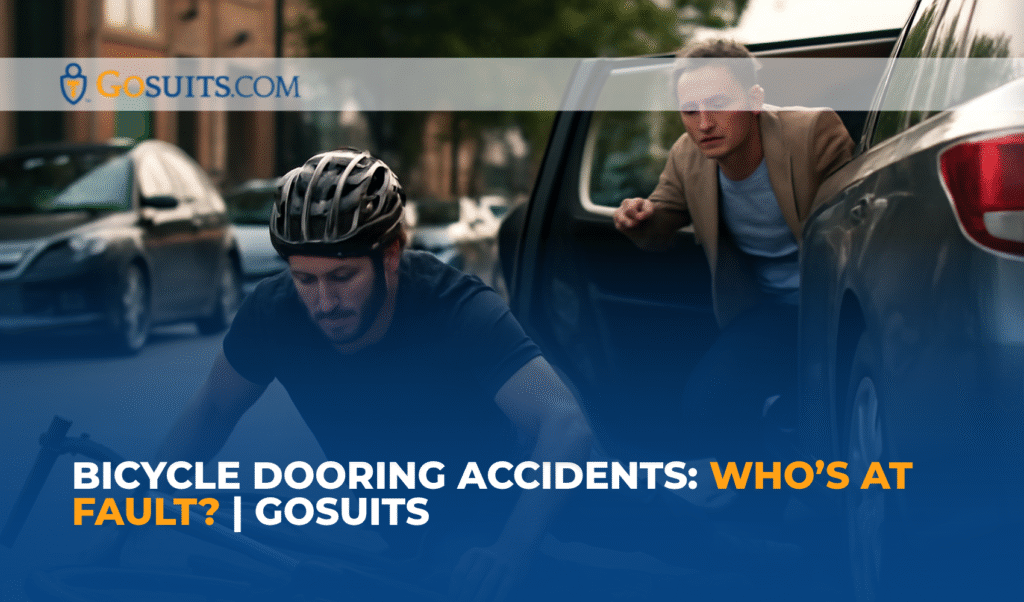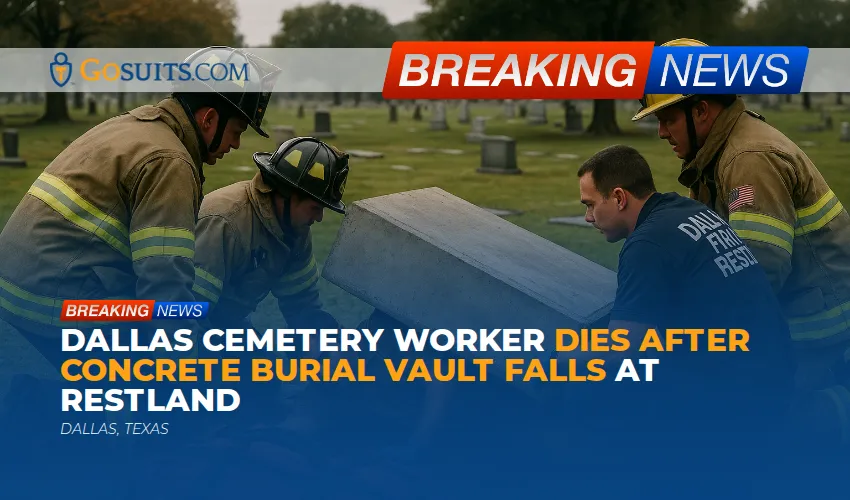- What happened in Union City
- Known details and what remains under investigation
- Who to contact for official information and records
- Pedestrian rights and key California laws
- Potential civil liability and how it is evaluated
- Evidence families may seek to preserve
- Insurance issues common in fatal pedestrian crashes
- Timelines and critical filing deadlines in California
- Support resources, victim compensation, and records access
- Safety context: pedestrian risk factors and roadway design
- Commentary from Gosuits Union City, California Personal Injury Attorney
- Why taking action matters now
- Government and academic sources cited
What happened in Union City
According to Union City police statements reported publicly, a driver struck a 55-year-old pedestrian around 6:25 a.m. on Wednesday at the intersection of Decoto Road and Royal Ann Drive in Union City. The pedestrian was crossing Decoto Road and was pronounced deceased at the scene. The driver remained at the site and cooperated with the investigation. Police said impairment did not appear to be a factor. Southbound Decoto Road was closed for the investigation and reopened around midday. As of the latest report, the man’s identity was withheld pending notification of next of kin.
Authorities asked anyone with information to contact Officer Michael Silva at 510-675-5222 or via email at michaels@unioncity.org. This is the city’s fourth fatal collision reported this year.
Known details and what remains under investigation
What is known
Based on the information shared by the Union City Police Department:
- Location and time: Decoto Road at Royal Ann Drive, approximately 6:25 a.m.
- Outcome: The pedestrian, a 55-year-old man, died at the scene.
- Driver status: The driver stopped and cooperated with police.
- Impairment: Drug or alcohol impairment did not appear to play a role, per police.
- Road closure: Southbound Decoto Road was closed during the investigation and reopened around noon.
What investigators typically review in a fatal pedestrian crash
Even when impairment is not suspected, investigators often examine many factors before determining fault:
- Right-of-way: Whether the pedestrian was in a crosswalk and if signals or signage indicated a permitted crossing phase.
- Driver conduct: Speed, attentiveness, and compliance with traffic signals and crosswalk laws.
- Visibility and lighting: Early morning light levels, street lighting, weather, and sightlines (including potential obstructions).
- Roadway conditions: Marked or unmarked crosswalk status, signal timing and phasing, nearby bus stops, lane design, and signage condition.
- Vehicle factors: Headlight operation, windshield visibility, braking and event data recorder information (if available).
- Witness accounts and video: Third-party statements and any available surveillance or dashcam footage.
It is common for conclusions to evolve as more evidence is gathered. Families often benefit from collecting their own copies of records and preserving any photographs or video relevant to the intersection or conditions at the time.
Who to contact for official information and records
Local police report and collision records
Union City Police Department handles the collision investigation. Requesting the traffic collision report can help clarify key details such as diagrammed positions, measurements, witness statements, lighting and weather notations, vehicle orientation, and any citations. California law restricts who may obtain collision reports, but next of kin, legal representatives, and involved parties are generally eligible under California Vehicle Code provisions and agency policy. The department provided a direct contact for tips and information: Officer Michael Silva, 510-675-5222, michaels@unioncity.org.
Important note about access: Under California Vehicle Code confidentiality rules, collision reports are not public and are typically released only to specified persons and entities with a proper interest. See the California Legislative Information website for statutory text and related privacy restrictions.
Coroner/Medical Examiner and autopsy or examination records
For deaths in Union City, the coroner functions are overseen at the county level. Families may request information about the cause and manner of death, copies of the autopsy report (if one is performed), and related records. Fees and release timing can be governed by statute and county policy. California Government Code authorizes certain cost recovery by a coroner for reports and services; families should ask what documents are available and what proof of relationship is required. If you are not sure which office to call, ask Union City Police to confirm the county coroner/medical examiner handling the case and the report number associated with the decedent.
Death certificates
Death certificates in California are issued through the California Department of Public Health (CDPH) Vital Records and county vital records offices. Certified copies are often needed for estate matters and potential civil claims. CDPH provides instructions on who can order certified copies and what documentation is required. See CDPH’s Vital Records pages for process and eligibility details at cdph.ca.gov.
Public records that may be helpful
- Signal timing and phasing: Families sometimes request traffic signal timing charts, pedestrian phase timing, and recent maintenance or change logs for the intersection. These can be requested under the California Public Records Act (CPRA). See the California Attorney General’s CPRA overview at oag.ca.gov for how to make a records request.
- Roadway design and safety studies: Requests can include crosswalk striping plans, illumination plans, crash history summaries, and any recent safety audits for Decoto Road and Royal Ann Drive.
- 911 audio and dispatch logs: Dispatch records may help establish timelines. Access may be limited or redacted depending on privacy rules.
Pedestrian rights and key California laws
California law sets clear expectations for both drivers and pedestrians. The right-of-way rules, the duty of care, and the rules for bringing civil claims are codified across several statutes and judicial council instructions.
- Right-of-way in crosswalks: California Vehicle Code section 21950 outlines that drivers must yield the right-of-way to pedestrians crossing within marked crosswalks or unmarked crosswalks at intersections, and must exercise due care to avoid colliding with a pedestrian. It also specifies that pedestrians have responsibilities not to suddenly leave a curb and unnecessarily stop or delay traffic. See the statutory text at the state’s legislative website: leginfo.legislature.ca.gov.
- Comparative fault: In California civil cases, responsibility for damages can be reduced in proportion to any share of fault attributed to a claimant, a concept commonly referred to as comparative negligence. The Judicial Council of California provides civil jury instructions that discuss how juries evaluate comparative fault and causation. See the Judicial Council resources at courts.ca.gov.
- Wrongful death and survival claims:
- Wrongful death claims are authorized by Code of Civil Procedure section 377.60 for certain family members. Text: leginfo.legislature.ca.gov.
- Survival actions, which allow the decedent’s estate to recover certain damages that the decedent could have recovered had they lived, are authorized by Code of Civil Procedure section 377.30. Text: leginfo.legislature.ca.gov.
These laws work together to frame how investigators, insurers, and, if necessary, courts evaluate a pedestrian fatality. The specifics of any one collision depend on the evidence and the unique facts of the roadway and the people involved.
Potential civil liability and how it is evaluated
Driver liability considerations
Where a pedestrian is struck while crossing a roadway, analysis often starts with whether the driver complied with the duty to yield and to exercise due care. Potential negligence theories can include failing to yield at a crosswalk, unsafe speed for conditions, distraction or inattention, and failure to ensure the intersection was clear before proceeding. The absence of impairment does not resolve questions of negligence. A driver may be fully compliant, partially at fault, or not at fault; the determination is evidence-driven.
Pedestrian conduct
Courts and insurers also evaluate whether a pedestrian complied with pedestrian signals and acted with reasonable care for their own safety. California law allows a fact-finder to reduce damages by the percentage of fault allocated to a pedestrian, if any, while still permitting recovery for the fault allocated to others.
Public entity liability for roadway conditions
Sometimes a collision involves potential roadway or intersection issues. California Government Code section 835 provides a framework for claims against public entities when a “dangerous condition of public property” contributed to injury or death. For example, inadequate lighting, faded crosswalk markings, signal timing that does not provide adequate pedestrian clearance, or sightline obstructions can be scrutinized. These claims are highly fact-specific and typically require expert investigation, records requests, and timely compliance with special claim procedures before suit. Statutory text: leginfo.legislature.ca.gov.

Evidence families may seek to preserve
Early preservation helps prevent the loss of critical information. Without speculating on fault in this case, here are common evidence items that can matter in any pedestrian fatality at an intersection:
- Scene documentation: Photos or video of the crosswalk, signal heads, push-buttons, lighting fixtures, lane markings, and any obstructions. Document conditions around 6:25 a.m. if safely possible on a similar day to capture comparable light levels.
- Businesses or residences near the intersection: Politely ask whether they have exterior cameras that might have captured the crosswalk or approach lanes. Video systems often overwrite quickly.
- Vehicle data: Some vehicles store speed and braking data on an event data recorder. Preservation requests are time-sensitive.
- Signal timing records: Request pedestrian “WALK,” flashing “DON’T WALK,” and solid “DON’T WALK” timing, clearance intervals, and any recent changes.
- Maintenance and complaints: Records of past complaints or recent maintenance at the intersection can help assess whether known hazards existed.
- Medical and coroner records: Autopsy findings, cause and manner of death, and trauma documentation can inform reconstruction and damages.
Public records requests can be made under the California Public Records Act. The Attorney General’s CPRA resource page explains the process and response timelines at oag.ca.gov.
Insurance issues common in fatal pedestrian crashes
Insurance can be complex in pedestrian cases, especially where multiple coverages may apply. Before speaking with any insurance adjuster, it is wise to consult an attorney to understand rights and potential exposures. Statements made to an insurer can be used to limit or deny claims later.
- At-fault driver’s liability insurance: If a driver is found negligent, their liability policy may be the primary source of recovery. Liability limits vary and may be insufficient for a fatality.
- Uninsured/Underinsured Motorist (UM/UIM): Pedestrians can sometimes access UM/UIM benefits under their own auto policy or a policy of a household member, even though they were not in a vehicle. Coverage depends on the policy terms. The California Department of Insurance provides consumer information on auto policy coverages at insurance.ca.gov.
- MedPay: Some auto policies include medical payments coverage that may help with certain expenses, regardless of fault, subject to policy language.
- Homeowner or umbrella policies: Additional layers of liability coverage may exist for the driver or, in some instances, supplemental coverages for the decedent’s household.
- Public entity risk pools: If a roadway defect claim is viable, coverage is handled through the entity’s self-insurance or risk pool, with strict notice requirements.
Be cautious when discussing the incident with any insurer. Early recorded statements, authorizations, or partial settlements can affect future rights. Consider getting a free consultation to understand options before engaging.
Timelines and critical filing deadlines in California
- Wrongful death and survival actions: In most cases, a two-year statute of limitations applies to wrongful death and personal injury claims in California. See Code of Civil Procedure section 335.1 at leginfo.legislature.ca.gov.
- Claims against public entities: Claims alleging a dangerous condition of public property require an administrative claim to be filed typically within six months of the incident under the Government Claims Act. See Government Code section 911.2 at leginfo.legislature.ca.gov.
- Requesting records: Agencies must respond to CPRA requests within set time frames, generally within 10 days to acknowledge and explain whether records will be produced. See the Attorney General’s CPRA guidance at oag.ca.gov.
These deadlines can be unforgiving. When in doubt, confirm the exact timeline that applies to your situation as soon as possible.
Support resources, victim compensation, and records access
California victim compensation
The California Victim Compensation Board (CalVCB) may assist eligible families with certain crime-related expenses, though eligibility depends on the circumstances and whether the event meets statutory definitions. Learn more at victims.ca.gov. Even when a crash is not treated as a crime, other community resources may be available through local victim services programs or county assistance offices.
Death certificates and vital records
Certified death certificates are typically needed for insurance, financial, and estate matters. CDPH Vital Records provides guidance at cdph.ca.gov. County vital records offices can also help.
Obtaining police and coroner reports
- Police report: Contact Union City Police Department records to request the traffic collision report. Be ready to provide the date, intersection (Decoto Road and Royal Ann Drive), and the report or incident number if known. California Vehicle Code confidentiality rules limit access to certain parties.
- Coroner/Medical Examiner: Ask the county coroner or medical examiner about the availability of autopsy or examination reports, cause and manner of death findings, and toxicology if performed. California Government Code authorizes fees for these reports, and release may take several weeks depending on testing.
Where else to call
- Union City Police Department: For status updates and records unit information. Tip contact provided by UCPD: Officer Michael Silva, 510-675-5222, michaels@unioncity.org.
- County Coroner/Medical Examiner: To confirm jurisdiction, case number, and report availability.
- California Department of Public Health: For certified death certificates. See CDPH guidance at cdph.ca.gov.
- California Department of Insurance: For general information about auto coverage and claims processes at insurance.ca.gov.
Safety context: pedestrian risk factors and roadway design
Pedestrian safety at dawn and during low-light periods is a national priority. Federal and state transportation agencies highlight several factors that tend to increase risk and potential countermeasures that can reduce it.
Risk factors highlighted by national and state agencies
- Low-light conditions: A significant share of pedestrian fatalities occur in dark or low-light conditions, often outside of daylight hours. See the National Highway Traffic Safety Administration’s pedestrian safety overview at nhtsa.gov.
- Vehicle speed: Higher speeds increase both crash likelihood and severity for pedestrians. NHTSA provides guidance on speed management and pedestrian safety at nhtsa.gov.
- Intersection design: Crossing distance, refuge islands, and leading pedestrian intervals can affect safety. The Federal Highway Administration describes proven pedestrian countermeasures at safety.fhwa.dot.gov.
- Visibility: Enhanced crosswalk markings, adequate street lighting, and clear sightlines can make a difference. FHWA’s resources on lighting and crosswalk visibility are available via safety.fhwa.dot.gov.
- California trends: The California Office of Traffic Safety tracks pedestrian safety program priorities statewide; see OTS program pages at ots.ca.gov.
Why timing and phasing matter at intersections
Signal timing defines how long a pedestrian has to start and finish crossing. Federal guidance recommends timing that accounts for walking speed assumptions and provides adequate clearance intervals. If an interval is too short for typical users, or if a leading pedestrian interval is absent where needed, conflict potential can rise. Records of the timing plan and any recent changes can help clarify whether timing contributed to a conflict phase.
Education and driver duty
California emphasizes that drivers must exercise due care to avoid pedestrians and to yield at crosswalks. Resources from NHTSA and the California DMV reinforce this shared responsibility. See NHTSA’s pedestrian safety page at nhtsa.gov and DMV driver safety materials at dmv.ca.gov.

Commentary from Gosuits Union City, California Personal Injury Attorney
Our hearts go out to the family and loved ones affected by the fatal collision at Decoto Road and Royal Ann Drive. Losing someone in a road incident is devastating, and the first days are often filled with shock, grief, and unanswered questions. This article is intended for general information and education to help community members understand the process and their options. It is not a substitute for advice about any specific situation.
From a civil injury perspective, even when impairment is not suspected, a thorough review is still essential. Key focus areas in an early morning intersection collision include whether the pedestrian had the right-of-way, driver attentiveness and speed relative to conditions, and whether roadway lighting, signal timing, or crosswalk visibility contributed to the risk. We often see that the truth of what happened only becomes clear after gathering the official reports, signal timing data, and any available video. It is important to let the evidence guide conclusions.
Insurance companies and large entities frequently move quickly after serious incidents, sometimes asking families for statements or broad medical authorizations. Adjusters are trained to minimize exposure. Without context, a well-meaning answer to a question can be used later to reduce or deny a claim. Corporations and insurers also control much of the information at the outset, while families are still seeking basic records. Early guidance can help level the playing field, ensure critical evidence is preserved, and prevent unintentional waivers.
Speaking with a seasoned attorney for a free consultation can help clarify rights, applicable deadlines, and what to expect from insurers and public entities. It can also help families avoid missteps, like missing a short deadline for a public entity claim or giving a recorded statement that can be taken out of context. No one should have to navigate this process alone.
Why taking action matters now
- Confirm key deadlines: California’s two-year wrongful death statute and the six-month public entity claim deadline leave little margin for error. Confirm which timeline applies and calendar it immediately.
- Preserve evidence: Intersection video, nearby business footage, and vehicle data can be overwritten or lost within days. Ask witnesses for contact information and request that potential video sources preserve footage.
- Request critical records: Initiate requests for the police collision report and, when eligible, coroner findings and death certificates. If roadway conditions may be an issue, prepare a CPRA request for signal timing, maintenance logs, and crosswalk plans. The Attorney General’s page explains CPRA basics at oag.ca.gov.
- Avoid recorded statements to insurers without guidance: What is said can be used to reduce or deny claims. Consulting counsel first can help protect rights.
- Document losses: Keep a dated file with funeral expenses, travel, work leave documentation, and communications with insurers or agencies. These records support later claims.
- Explore benefits: Review potential UM/UIM coverage under applicable auto policies and check state resources such as the California Department of Insurance at insurance.ca.gov and victim assistance information at victims.ca.gov.
Government and academic sources cited
- California Vehicle Code § 21950 (Pedestrian right-of-way): leginfo.legislature.ca.gov
- Code of Civil Procedure § 377.60 (Wrongful death): leginfo.legislature.ca.gov
- Code of Civil Procedure § 377.30 (Survival action): leginfo.legislature.ca.gov
- Code of Civil Procedure § 335.1 (Two-year statute of limitations for wrongful death): leginfo.legislature.ca.gov
- Government Code § 835 (Dangerous condition of public property): leginfo.legislature.ca.gov
- Government Code § 911.2 (Government claims deadline): leginfo.legislature.ca.gov
- California Public Records Act overview: oag.ca.gov
- California Department of Public Health, Vital Records: cdph.ca.gov
- California Department of Insurance, Consumer information: insurance.ca.gov
- California Victim Compensation Board: victims.ca.gov
- NHTSA, Pedestrian Safety: nhtsa.gov
- NHTSA, Speeding and safety: nhtsa.gov
- FHWA, Proven Safety Countermeasures (pedestrian): safety.fhwa.dot.gov
- California Office of Traffic Safety, Pedestrian and Bicycle Safety: ots.ca.gov
- California Courts, Judicial Council resources (comparative fault context): courts.ca.gov






